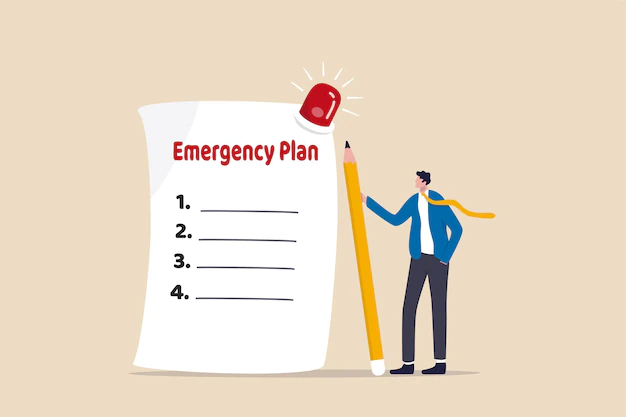In 2022 alone, the U.S. sustained 15 extreme weather or climate emergencies, the National Oceanic and Atmospheric Administration (NOAA) reports. Each of these natural disasters was responsible for causing over $1 billion in the home or business damages. Even more alarming, the NOAA estimates 342 weather-related fatalities overall this year.
You can’t always prevent a disaster from occurring, nor can you predict the scale of devastation it might leave in its wake. But you can create and execute an emergency plan to keep your loved ones safe. Preparedness can mean the difference between life and death in the event of an emergency, so follow this checklist to help your whole family plan ahead, take action and minimize the long-term impacts when a disaster strikes.
Minimize the Risk of Emergencies as Much as Possible
Many catastrophic events—such as hurricanes, tornadoes, or earthquakes—are outside of your control. But some disasters are preventable to a certain extent. House fires, for instance, are often caused by human error. In fact, the main culprits of a structural fire are cooking, electrical, and heating hazards, pointing to the National Fire Protection Association (NFPA). Therefore, it’s crucial to minimize this threat in the first place. Here are a few simple but effective strategies to lower the risk of an avoidable emergency:
- Inspect all electrical cords to look for faulty circuits and unplug any devices, not in use.
- Use a surge protector—also called a power strip—to charge computers, mobile phones, game systems, televisions, and other low-voltage tech.
- Keep all flames or heat conductors away from flammable surfaces and materials. Do not leave an unsupervised open flame (e.g., candle, stovetop burner).
- Eliminate excess clutter in the home, as these items can cause a fire to spread quickly.
- Change out air filters every month and remove any lint build-up from appliances.
- Turn off all the lights and electrical or heated appliances whenever you are not at home.
- Conduct regular inspections on the furnace, HVAC unit, fire extinguisher, and sprinklers.
Determine How to Evacuate and Where to Seek Shelter
In the case of a severe storm, flooding, earthquake, or wildfire, the region where you live could issue a mandatory evacuation. When this occurs, you’ll need to leave home for a minimum of 24 hours—but it can last days or weeks, based on the scope of the damage. When you’re forced to evacuate (especially on short notice when a disaster strikes without warning), separating from family members is easy.
This is why ironing out your evacuation plan ahead of time is vital so that no one will be lost in the shuffle. As a family, talk about how to escape the house, which valuables or essentials to grab (if possible), and where to reconnect and seek shelter. Most towns and cities will convert schools, hospitals, community centers, athletic stadiums, hotels, or other public venues into free emergency shelters. Check online to see where the nearest shelter is located, then practice getting there, so everyone knows the route.
Have an Emergency Contact List in Case of Separation
A communication plan is equally critical in the event of separation. Make sure that all household members have each other’s phone numbers, emails, and social media accounts written down in a safe, accessible place. It’s also smart to include the contact details of local shelters, first response agencies, crisis hotlines, emergency healthcare facilities, and relatives or friends in the vicinity who might be able to help.
Not only should all this information be saved securely on mobile devices, but everyone should also have a hardcopy contact sheet as a backup in case their phone battery dies. Extreme weather will often cause power outages, so it could be a while before you’re able to touch base. Having as much contact information as possible at your fingertips will facilitate smoother, easier communication once the power is restored.
Assemble a Preparedness Kit with the Basic Essentials
If you have to shelter in place (either at home or in a vehicle) until a natural disaster passes, compile an emergency kit, then store it in a secure but reachable spot to access at a moment’s notice. This kit should contain the most basic essentials you’ll need to survive as a family for a prolonged time. Even once an immediate threat of danger is over, sometimes it can be several days until all the roads clear, power lines turn back on, and stores reopen. So be sure to stockpile the following items in advance:
- Two cases of water
- Non-perishable food
- Manual can opener
- First aid supplies
- Medications
- NOAA weather radio
- Map of the local area
- Flashlight with extra batteries
- Whistle to signal for help
- Heavy blankets
- Duct tape and tarp sheets
- Mobile phone chargers
- N-95 face masks
- Personal sanitation items
- Multi-tool pliers
Hire a Professional Service to Build Out an Action Plan
These precautions will get you started on an effective emergency plan. But if you want to take it a step further and create even more safeguards to protect your loved ones and your home or business—it’s time to contact an emergency readiness service. These professionals will thoroughly evaluate your space to detect vulnerable areas or safety hazards. They will work with you to build a strategy to minimize the risk of harm and help you recover from potential losses in the aftermath. Disasters happen, so decisive action is key.







